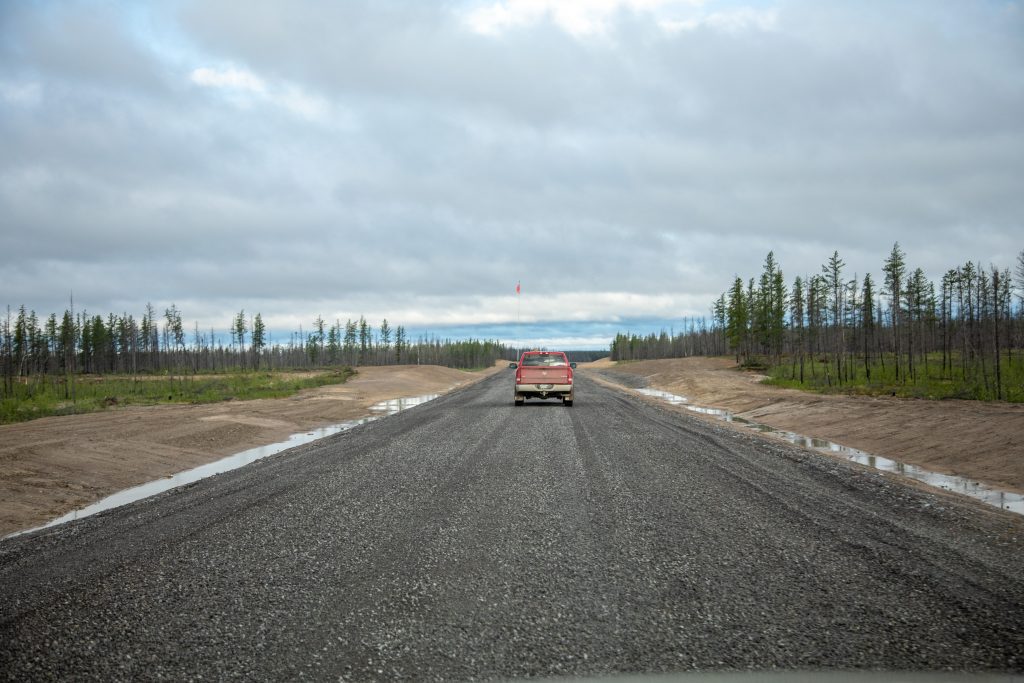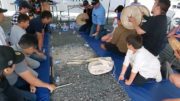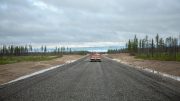While the Chief of Whatì, Alfonz Nitsiza, reported a sure sense of excitement over the opening of the Tłı̨chǫ Highway this fall, he also spoke of concerns in the community.
“They also are concerned about the impact and the influx of people that might be coming out,” he said.
Chief Nitsiza said that he knows there will be change in the community and some fear that change.
Whether that change will be to the demographics, health of the community or land itself, the impacts of the highway opening will be monitored closely.
This monitoring will be done in a joint effort between the Tłı̨chǫ Government, Community Government of Whatì and Government of the Northwest Territories with a health and well-being working group.
The group was established in 2019 as directed by an environmental assessment of the road.

A finished section of the Tłı̨chǫ Highway. The territorial and Tłı̨chǫ government’s are collaborating on a project “piggybacking” on the road that could bring a fibre optic cable to Whatì. (Photo courtesy of the GNWT.)
Lisa Nitsiza, senior administrative officer for Whatì, said it’s been a long process but the group is working well together.
“It’s great to have this support team,” she said.
She added the community government was holding public meetings to hear from residents, but those have slowed due to public health orders around the COVID-19 pandemic.
So far, according to Nitsiza, the community is concerned about an influx of non-members coming in, the risk of excessive boating affecting fishing, maintaining clean waterfalls, as well as the land beyond the community’s boundaries on the lake.
But these won’t be the only areas of potential change that the working group will be monitoring.
According to Damien Healy, communications manager for the Department of Health and Social Services (HSS), the three governments are participating in the development of a health and well-being monitoring plan in preparation of the opening of the highway.
This plan involves identifying qualitative and quantitative indicators that will be monitored and reported on annually with the community.
“Our approach is collaborative, focusing on the strengths and expertise that each organization and participant brings to informing a monitoring framework that is responsive and that reflects the culture, values, needs and concerns of the Tłı̨chǫ,” said Healy.
For the monitoring program, the group is working towards identifying data sources, key community concerns, indicators, and determining community specific and culturally appropriate approaches to mitigation measures.
“We really rely heavily on the Bureau of Statistics to provide us information,” Ginger Gibson, a contractor with the Tłı̨chǫ Government leading socio-economic research, said.
The working group will be monitoring areas such as demographics – whether population is decreasing and the community is suffering “brain drain” – and population health statistics such as rates of sexually transmitted diseases, whether the need for counselling around drugs and alcohol increases, if the need for mental health counselling increases, or if visits to the health centre increases.
“We also look at Child and Family Services, economic well-being, cultural well-being … early childhood and education, community safety and policing,” Gibson said. She noted that school attendance tends to dip when the winter road open, so the group is looking to ensure this doesn’t become a year-round issue.
“So, we have quite a few areas that we’re collecting data on.”
Gibson said that with the hard work of all three governments and their co-operation, Whatì is poised to have “really good, strong monitoring system in place.”
In addition to collecting data for the Bureau of Statistics, the working group has also been receiving updates on crime statistics from the RCMP on a monthly basis. They also sit in on group meetings.
Police services ‘may change’
“Whatì RCMP have a constant dialogue with the Whatì Government and Chief and Council,” said Marie York-Condon, media relations officer with the NT RCMP.
After the road opens, police services in Whatì and Behchokǫ̀ “may change” as two-thirds of the highway are in Behchoko’s jurisdiction and their members may be called upon for collisions, animal strikes and stranded motorists.
“The remainder will be the responsibility of the Whatì detachment but the detachments will work together to deliver an effective policing service,” she said.
Currently there are two officers stationed in Whatì. While the ice road is open, York-Condon said calls to service increase and the detachment is expecting an increase in calls once the community is accessible year-round.
In the months of March and April, there were 246 calls for service. Those same months saw nine seizures of illegal liquor resulting in 48 bottles (of varying sizes) of hard liquor and 35 beers being seized.
Whatì is a dry community and RCMP there have enforcing this as one of their policing priorities, said York-Condon.
The working group is finalizing the monitoring framework prior to the road opening and identifying culturally appropriate qualitative data collection and social monitoring with the community.
The monitoring is expected to take place for 10 years.









